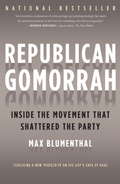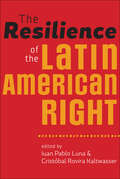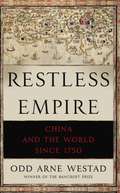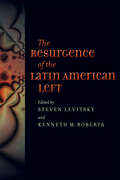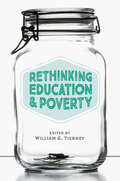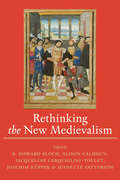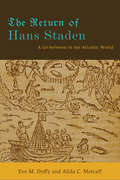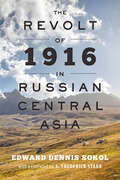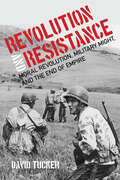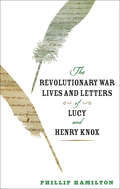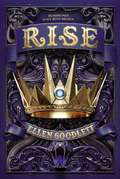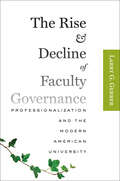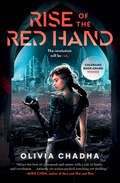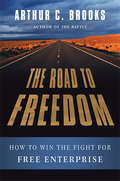- Table View
- List View
Republican Gomorrah: Inside the Movement that Shattered the Party
by Max BlumenthalOver the last year, award-winning journalist and videographer Max Blumenthal has been behind some of the most sensational (and funniest) exposes of Republican machinations. Whether it was his revelation that Sarah Palin was "anointed" by a Kenyan priest famous for casting out witches, or his confronting Republican congressional leaders and John McCain's family at the GOP convention about the party's opposition to sex education (and hence, the rise in teen pregnancies like that of Palin's daughter), or his expose of the eccentric multimillionaire theocrat behind California's Prop 8 anti- gay marriage initiative, Blumenthal has become one of the most important and most constantly cited journalists on how fringe movements are becoming the Republican Party mainstream.Republican Gomorrah is a bestiary of dysfunction, scandal and sordidness from the dark heart of the forces that now have a leash on the party. It shows how those forces are the ones that establishment Republicans-like John McCain-have to bow to if they have any hope of running for President. It shows that Sarah Palin was the logical choice of a party in the control of theocrats. But more that just an expose, Republican Gomorrah shows that many of the movement's leading figures have more in common than just the power they command within conservative ranks. Their personal lives have been stained by crisis and scandal: depression, mental illness, extra-marital affairs, struggles with homosexual urges, heavy medication, addiction to pornography, serial domestic abuse, and even murder. Inspired by the work of psychologists Erich Fromm, who asserted that the fear of freedom propels anxiety-ridden people into authoritarian settings, Blumenthal explains in a compelling narrative how a culture of personal crisis has defined the radical right, transforming the nature of the Republican Party for the next generation and setting the stage for the future of American politics.
Republican Gomorrah: Inside the Movement that Shattered the Party
by Max BlumenthalOver the last year, award-winning journalist and videographer Max Blumenthal has been behind some of the most sensational (and funniest) exposes of Republican machinations. Whether it was his revelation that Sarah Palin was "anointed" by a Kenyan priest famous for casting out witches, or his confronting Republican congressional leaders and John McCain's family at the GOP convention about the party's opposition to sex education (and hence, the rise in teen pregnancies like that of Palin's daughter), or his expose of the eccentric multimillionaire theocrat behind California's Prop 8 anti- gay marriage initiative, Blumenthal has become one of the most important and most constantly cited journalists on how fringe movements are becoming the Republican Party mainstream.Republican Gomorrah is a bestiary of dysfunction, scandal and sordidness from the dark heart of the forces that now have a leash on the party. It shows how those forces are the ones that establishment Republicans-like John McCain-have to bow to if they have any hope of running for President. It shows that Sarah Palin was the logical choice of a party in the control of theocrats. But more that just an expose, Republican Gomorrah shows that many of the movement's leading figures have more in common than just the power they command within conservative ranks. Their personal lives have been stained by crisis and scandal: depression, mental illness, extra-marital affairs, struggles with homosexual urges, heavy medication, addiction to pornography, serial domestic abuse, and even murder. Inspired by the work of psychologists Erich Fromm, who asserted that the fear of freedom propels anxiety-ridden people into authoritarian settings, Blumenthal explains in a compelling narrative how a culture of personal crisis has defined the radical right, transforming the nature of the Republican Party for the next generation and setting the stage for the future of American politics.
The Resilience of the Latin American Right
by Juan Pablo Luna Cristóbal Rovira KaltwasserSince the late 1990s, when Latin American countries began making a "turn to the left," political parties and candidates on the right end of the partisan spectrum have had a difficult time achieving electoral success. Although the left turn can be seen as a natural reaction to the public’s general dissatisfaction with the conservative modernization policies of the 1980s and 1990s, left-of-center politics are by no means permanent. In The Resilience of the Latin American Right, Juan Pablo Luna and Cristóbal Rovira Kaltwasser seek to "right" this view by explaining the strategies conservative political parties have used to maintain a foothold in the region’s electoral and governance processes. The editors provide an analytical framework for conceptualizing the right that works for both historic and contemporary politics, and the volume’s contributors use the framework to evaluate right-of-center political activity across the continent. They find that conservative forces are pursuing a range of adaptive strategies, including nonelectroral and nonpartisan tactics. The book’s four thematic sections include an analysis of parties and elections in Argentina, Bolivia, Brazil, Chile, Colombia, Ecuador, El Salvador, Mexico, Peru, and Venezuela.Students and scholars of both Latin American politics and comparative politics will find The Resilience of the Latin American Right of vital interest.
The Resilience of the Latin American Right
by Juan Pablo Luna Cristóbal Rovira KaltwasserSince the late 1990s, when Latin American countries began making a "turn to the left," political parties and candidates on the right end of the partisan spectrum have had a difficult time achieving electoral success. Although the left turn can be seen as a natural reaction to the public’s general dissatisfaction with the conservative modernization policies of the 1980s and 1990s, left-of-center politics are by no means permanent. In The Resilience of the Latin American Right, Juan Pablo Luna and Cristóbal Rovira Kaltwasser seek to "right" this view by explaining the strategies conservative political parties have used to maintain a foothold in the region’s electoral and governance processes. The editors provide an analytical framework for conceptualizing the right that works for both historic and contemporary politics, and the volume’s contributors use the framework to evaluate right-of-center political activity across the continent. They find that conservative forces are pursuing a range of adaptive strategies, including nonelectroral and nonpartisan tactics. The book’s four thematic sections include an analysis of parties and elections in Argentina, Bolivia, Brazil, Chile, Colombia, Ecuador, El Salvador, Mexico, Peru, and Venezuela.Students and scholars of both Latin American politics and comparative politics will find The Resilience of the Latin American Right of vital interest.
Restless Empire: China and the World Since 1750
by Odd Arne Westad"A fascinating book and a pleasure to read.... Full of interesting details and insights." --Gideon Rachman, Financial TimesAs the twenty-first century dawns, China stands at a crossroads. The largest and most populous country on earth and currently the world's second biggest economy, China has recently reclaimed its historic place at the center of global affairs after decades of internal chaos and disastrous foreign relations. But even as China tentatively reengages with the outside world, the contradictions of its development risks pushing it back into an era of insularity and instability--a regression that, as China's recent history shows, would have serious implications for all other nations.In Restless Empire, award-winning historian Odd Arne Westad traces China's complex foreign affairs over the past 250 years, identifying the forces that will determine the country's path in the decades to come. Since the height of the Qing Empire in the eighteenth century, China's interactions--and confrontations--with foreign powers have caused its worldview to fluctuate wildly between extremes of dominance and subjugation, emulation and defiance. From the invasion of Burma in the 1760s to the Boxer Rebellion in the early 20th century to the 2001 standoff over a downed U.S. spy plane, many of these encounters have left Chinese with a lingering sense of humiliation and resentment, and inflamed their notions of justice, hierarchy, and Chinese centrality in world affairs. Recently, China's rising influence on the world stage has shown what the country stands to gain from international cooperation and openness. But as Westad shows, the nation's success will ultimately hinge on its ability to engage with potential international partners while simultaneously safeguarding its own strength and stability.An in-depth study by one of our most respected authorities on international relations and contemporary East Asian history, Restless Empire is essential reading for anyone wishing to understand the recent past and probable future of this dynamic and complex nation.
The Resurgence of the Latin American Left
by Steven Levitsky Kenneth M. RobertsLatin America experienced an unprecedented wave of left-leaning governments between 1998 and 2010. This volume examines the causes of this leftward turn and the consequences it carries for the region in the twenty-first century.The Resurgence of the Latin American Left asks three central questions: Why have left-wing parties and candidates flourished in Latin America? How have these leftist parties governed, particularly in terms of social and economic policy? What effects has the rise of the Left had on democracy and development in the region? The book addresses these questions through two sections. The first looks at several major themes regarding the contemporary Latin American Left, including whether Latin American public opinion actually shifted leftward in the 2000s, why the Left won in some countries but not in others, and how the left turn has affected market economies, social welfare, popular participation in politics, and citizenship rights. The second section examines social and economic policy and regime trajectories in eight cases: those of leftist governments in Argentina, Bolivia, Brazil, Chile, Ecuador, Uruguay, and Venezuela, as well as that of a historically populist party that governed on the right in Peru. Featuring a new typology of Left parties in Latin America, an original framework for identifying and categorizing variation among these governments, and contributions from prominent and influential scholars of Latin American politics, this historical-institutional approach to understanding the region’s left turn—and variation within it—is the most comprehensive explanation to date on the topic.
The Resurgence of the Latin American Left
by Kenneth M. Roberts Steven LevitskyLatin America experienced an unprecedented wave of left-leaning governments between 1998 and 2010. This volume examines the causes of this leftward turn and the consequences it carries for the region in the twenty-first century.The Resurgence of the Latin American Left asks three central questions: Why have left-wing parties and candidates flourished in Latin America? How have these leftist parties governed, particularly in terms of social and economic policy? What effects has the rise of the Left had on democracy and development in the region? The book addresses these questions through two sections. The first looks at several major themes regarding the contemporary Latin American Left, including whether Latin American public opinion actually shifted leftward in the 2000s, why the Left won in some countries but not in others, and how the left turn has affected market economies, social welfare, popular participation in politics, and citizenship rights. The second section examines social and economic policy and regime trajectories in eight cases: those of leftist governments in Argentina, Bolivia, Brazil, Chile, Ecuador, Uruguay, and Venezuela, as well as that of a historically populist party that governed on the right in Peru. Featuring a new typology of Left parties in Latin America, an original framework for identifying and categorizing variation among these governments, and contributions from prominent and influential scholars of Latin American politics, this historical-institutional approach to understanding the region’s left turn—and variation within it—is the most comprehensive explanation to date on the topic.
Rethinking Education and Poverty: Edited By William G. Tierney
by William G. TierneyIn Rethinking Education and Poverty, William G. Tierney brings together scholars from around the world to examine the complex relationship between poverty and education in the twenty-first century. International in scope, this book assembles the best contemporary thinking about how education can mediate class and improve the lives of marginalized individuals.In remarkably nuanced ways, this volume examines education's role as both a possible factor in perpetuating�and a tool for alleviating�entrenched poverty. Education has long been seen as a way out of poverty. Some critics, however, argue that educational systems mask inequality and perpetuate cycles of poverty and wealth; others believe that the innate resilience or intellectual ability of impoverished students is what allows those individuals to succeed. Rethinking Education and Poverty grapples in turn with the ramifications of each possibility.Throughout these compelling, far-reaching, and provocative essays, the contributors seek to better understand how local efforts to reduce poverty through education interact�or fail to interact�with international assessment efforts. They take a broad historical view, examining social, economic, and educational polices from the postWorld War II period to the end of the Cold War and beyond. Although there is no simple solution to inequality, this book makes clear that education offers numerous exciting possibilities for progress.
Rethinking the New Medievalism
by R. Howard Bloch Alison Calhoun Jacqueline Cerquiglini-Toulet Joachim Küpper Jeanette PattersonIn the early 1990s, Stephen Nichols introduced the term "new medievalism" to describe an alternative to the traditional philological approach to the study of the romantic texts in the medieval period. While the old approach focused on formal aspects of language, this new approach was historicist and moved beyond a narrow focus on language to examine the broader social and cultural contexts in which literary works were composed and disseminated. Within the field, this transformation of medieval studies was as important as the genetic revolution to the study of biology and has had an enormous influence on the study of medieval literature. Rethinking the New Medievalism offers both a historical account of the movement and its achievements while indicating—in Nichols’s innovative spirit—still newer directions for medieval studies.The essays deal with questions of authorship, theology, and material philology and are written by members of a wide philological and critical circle that Nichols nourished for forty years. Daniel Heller-Roazen’s essay, for example, demonstrates the conjunction of the old philology and the new. In a close examination of the history of the words used for maritime raiders from Ancient Greece to the present (pirate, plunderer, bandit), Roazen draws a fine line between lawlessness and lawfulness, between judicial action and war, between war and public policy. Other contributors include Jack Abecassis, Marina Brownlee, Jacqueline Cerquiglini-Toulet, Andreas Kablitz, and Ursula Peters.
Rethinking the New Medievalism
by R. Howard Bloch Jacqueline Cerquiglini-Toulet Alison Calhoun Joachim Küpper Jeanette PattersonIn the early 1990s, Stephen Nichols introduced the term "new medievalism" to describe an alternative to the traditional philological approach to the study of the romantic texts in the medieval period. While the old approach focused on formal aspects of language, this new approach was historicist and moved beyond a narrow focus on language to examine the broader social and cultural contexts in which literary works were composed and disseminated. Within the field, this transformation of medieval studies was as important as the genetic revolution to the study of biology and has had an enormous influence on the study of medieval literature. Rethinking the New Medievalism offers both a historical account of the movement and its achievements while indicatingâ€�in Nichols’s innovative spiritâ€�still newer directions for medieval studies.The essays deal with questions of authorship, theology, and material philology and are written by members of a wide philological and critical circle that Nichols nourished for forty years. Daniel Heller-Roazen’s essay, for example, demonstrates the conjunction of the old philology and the new. In a close examination of the history of the words used for maritime raiders from Ancient Greece to the present (pirate, plunderer, bandit), Roazen draws a fine line between lawlessness and lawfulness, between judicial action and war, between war and public policy. Other contributors include Jack Abecassis, Marina Brownlee, Jacqueline Cerquiglini-Toulet, Andreas Kablitz, and Ursula Peters.
The Return of Hans Staden: A Go-between in the Atlantic World
by Eve M. Duffy Alida C. MetcalfHans Staden’s sixteenth-century account of shipwreck and captivity by the Tupinambá Indians of Brazil was an early modern bestseller. This retelling of the German sailor’s eyewitness account known as the True History shows both why it was so popular at the time and why it remains an important tool for understanding the opening of the Atlantic world. Eve M. Duffy and Alida C. Metcalf carefully reconstruct Staden’s life as a German soldier, his two expeditions to the Americas, and his subsequent shipwreck, captivity, brush with cannibalism, escape, and return. The authors explore how these events and experiences were recreated in the text and images of the True History. Focusing on Staden’s multiple roles as a go-between, Duffy and Metcalf address many of the issues that emerge when cultures come into contact and conflict. An artful and accessible interpretation, The Return of Hans Staden takes a text best known for its sensational tale of cannibalism and shows how it can be reinterpreted as a window into the precariousness of lives on both sides of early modern encounters, when such issues as truth and lying, violence, religious belief, and cultural difference were key to the formation of the Atlantic world.
The Return of Hans Staden: A Go-between in the Atlantic World
by Alida C. Metcalf Eve M. DuffyHans Staden’s sixteenth-century account of shipwreck and captivity by the Tupinambá Indians of Brazil was an early modern bestseller. This retelling of the German sailor’s eyewitness account known as the True History shows both why it was so popular at the time and why it remains an important tool for understanding the opening of the Atlantic world. Eve M. Duffy and Alida C. Metcalf carefully reconstruct Staden’s life as a German soldier, his two expeditions to the Americas, and his subsequent shipwreck, captivity, brush with cannibalism, escape, and return. The authors explore how these events and experiences were recreated in the text and images of the True History. Focusing on Staden’s multiple roles as a go-between, Duffy and Metcalf address many of the issues that emerge when cultures come into contact and conflict. An artful and accessible interpretation, The Return of Hans Staden takes a text best known for its sensational tale of cannibalism and shows how it can be reinterpreted as a window into the precariousness of lives on both sides of early modern encounters, when such issues as truth and lying, violence, religious belief, and cultural difference were key to the formation of the Atlantic world.
The Revolt of 1916 in Russian Central Asia (The Johns Hopkins University Studies in Historical and Political Science #71)
by Edward Dennis SokolDuring the summer of 1916, approximately 270,000 Central Asians;¢;‚¬;€?Kazakhs, Kyrgyz, Tajiks, Turkmen, and Uzbeks;¢;‚¬;€?perished at the hands of the Russian army in a revolt that began with resistance to the Tsar;€™s World War I draft. In addition to those killed outright, tens of thousands of men, women, and children died while trying to escape over treacherous mountain passes into China. Experts calculate that the Kyrgyz, who suffered most heavily, lost 40% of their total population. This horrific incident was nearly lost to history. During the Soviet era, the massacre of 1916 became a taboo subject, hidden in sealed archives and banished from history books. Edward Dennis Sokol;€™s pioneering Revolt of 1916 in Russian Central Asia, published in 1954 and reissued now for the first time in decades, was for generations the only scholarly study of the massacre in any language. Drawing on early Soviet periodicals, including Krasnyi Arkhiv (The Red Archive), Sokol;€™s wide-ranging and exhaustively researched work explores the Tsarist policies that led to Russian encroachment against the land and rights of the indigenous Central Asian people. It describes the corruption that permeated Russian colonial rule and argues that the uprising was no mere draft riot, but a revolt against Tsarist colonialism in all its dimensions: economic, political, religious, and national. Sokol;€™s masterpiece also traces the chain reaction between the uprising, the collapse of Tsarism, and the Bolshevik Revolution. A classic study of a vanished world, Sokol's work takes on contemporary resonance in light of Vladimir Putin;€™s heavy-handed efforts to persuade Kyrgyzstan to join his new economic union. Sokol explains how;‚ an earlier Russian conquest ended in;‚ disaster and;‚ implies that a;‚ modern;‚ conquest might have the same effect. Essential reading for historians, political scientists, and policymakers, this reissued edition is being published to coincide with the centennial observation of the genocide.
The Revolt of 1916 in Russian Central Asia (The Johns Hopkins University Studies in Historical and Political Science #71)
by Edward Dennis SokolDuring the summer of 1916, approximately 270,000 Central Asians;¢;‚¬;€?Kazakhs, Kyrgyz, Tajiks, Turkmen, and Uzbeks;¢;‚¬;€?perished at the hands of the Russian army in a revolt that began with resistance to the Tsar;€™s World War I draft. In addition to those killed outright, tens of thousands of men, women, and children died while trying to escape over treacherous mountain passes into China. Experts calculate that the Kyrgyz, who suffered most heavily, lost 40% of their total population. This horrific incident was nearly lost to history. During the Soviet era, the massacre of 1916 became a taboo subject, hidden in sealed archives and banished from history books. Edward Dennis Sokol;€™s pioneering Revolt of 1916 in Russian Central Asia, published in 1954 and reissued now for the first time in decades, was for generations the only scholarly study of the massacre in any language. Drawing on early Soviet periodicals, including Krasnyi Arkhiv (The Red Archive), Sokol;€™s wide-ranging and exhaustively researched work explores the Tsarist policies that led to Russian encroachment against the land and rights of the indigenous Central Asian people. It describes the corruption that permeated Russian colonial rule and argues that the uprising was no mere draft riot, but a revolt against Tsarist colonialism in all its dimensions: economic, political, religious, and national. Sokol;€™s masterpiece also traces the chain reaction between the uprising, the collapse of Tsarism, and the Bolshevik Revolution. A classic study of a vanished world, Sokol's work takes on contemporary resonance in light of Vladimir Putin;€™s heavy-handed efforts to persuade Kyrgyzstan to join his new economic union. Sokol explains how;‚ an earlier Russian conquest ended in;‚ disaster and;‚ implies that a;‚ modern;‚ conquest might have the same effect. Essential reading for historians, political scientists, and policymakers, this reissued edition is being published to coincide with the centennial observation of the genocide.
Revolution and Resistance: Moral Revolution, Military Might, and the End of Empire
by David TuckerIn this provocative history, David Tucker argues that "irregular warfare";¢;‚¬;€?including terrorism, guerrilla warfare, and other insurgency tactics;¢;‚¬;€?is intimately linked to the rise and decline of Euro-American empire around the globe. Tracing the evolution of resistance warfare from the age of the conquistadors through the United States;€™ recent ventures in Afghanistan and Iraq, Revolution and Resistance demonstrates that contemporary conflicts in the Middle East, Africa, and Asia are simply the final stages in the unraveling of Euro-American imperialism. Tucker explores why it was so difficult for indigenous people and states to resist imperial power, which possessed superior military technology and was driven by a curious moral imperative to conquer. He also explains how native populations eventually learned to fight back by successfully combining guerrilla warfare with political warfare. By exploiting certain Euro-American weaknesses;¢;‚¬;€?above all, the instability created by the fading rationale for empire;¢;‚¬;€?insurgents were able to subvert imperialism by using its own ideologies against it. Tucker also examines how the development of free trade and world finance began to undermine the need for direct political control of foreign territory.Touching on Pontiac;€™s Rebellion of 1763, Abd el-Kader;€™s jihad in nineteenth-century Algeria, the national liberation movements that arose in twentieth-century Palestine, Vietnam, and Ireland, and contemporary terrorist activity, Revolution and Resistance shows how changing means have been used to wage the same struggle. Emphasizing moral rather than economic or technological explanations for the rise and fall of Euro-American imperialism, this concise, comprehensive book is required reading for anyone seeking to understand the character of contemporary conflict.
Revolution and Resistance: Moral Revolution, Military Might, and the End of Empire
by David TuckerIn this provocative history, David Tucker argues that "irregular warfare";¢;‚¬;€?including terrorism, guerrilla warfare, and other insurgency tactics;¢;‚¬;€?is intimately linked to the rise and decline of Euro-American empire around the globe. Tracing the evolution of resistance warfare from the age of the conquistadors through the United States;€™ recent ventures in Afghanistan and Iraq, Revolution and Resistance demonstrates that contemporary conflicts in the Middle East, Africa, and Asia are simply the final stages in the unraveling of Euro-American imperialism. Tucker explores why it was so difficult for indigenous people and states to resist imperial power, which possessed superior military technology and was driven by a curious moral imperative to conquer. He also explains how native populations eventually learned to fight back by successfully combining guerrilla warfare with political warfare. By exploiting certain Euro-American weaknesses;¢;‚¬;€?above all, the instability created by the fading rationale for empire;¢;‚¬;€?insurgents were able to subvert imperialism by using its own ideologies against it. Tucker also examines how the development of free trade and world finance began to undermine the need for direct political control of foreign territory.Touching on Pontiac;€™s Rebellion of 1763, Abd el-Kader;€™s jihad in nineteenth-century Algeria, the national liberation movements that arose in twentieth-century Palestine, Vietnam, and Ireland, and contemporary terrorist activity, Revolution and Resistance shows how changing means have been used to wage the same struggle. Emphasizing moral rather than economic or technological explanations for the rise and fall of Euro-American imperialism, this concise, comprehensive book is required reading for anyone seeking to understand the character of contemporary conflict.
The Revolutionary War Lives and Letters of Lucy and Henry Knox
by Phillip HamiltonIn 1774, Boston bookseller Henry Knox married Lucy Waldo Flucker, the daughter of a prominent Tory family. Although Lucy;€™s father was the third-ranking colonial official in Massachusetts, the couple joined the American cause after the Battles of Lexington and Concord and fled British-occupied Boston. Knox became a soldier in the Continental Army, where he served until the war;€™s end as Washington;€™s artillery commander.While Henry is well known to historians, his private life and marriage to Lucy remain largely unexplored. Phillip Hamilton tells the fascinating story of the Knoxes;€™ relationship amid the upheavals of war. Like John and Abigail Adams, the Knoxes were often separated by the revolution and spent much of their time writing to one another. They penned nearly 200 letters during the conflict, more than half of which are reproduced and annotated for this volume.This correspondence;¢;‚¬;€?one of the few collections of letters between revolutionary-era spouses that spans the entire war;¢;‚¬;€?provides a remarkable window into the couple;€™s marriage. Placed at the center of great events, struggling to cope with a momentous conflict, and attempting to preserve their marriage and family, the Knoxes wrote to each other in a direct and accessible manner as they negotiated shifts in gender and power relations. Working together, Henry and Lucy maintained their household and protected their property, raised and educated their children, and emotionally adjusted to other dramatic changes within their family, including a total break between Lucy and her Tory family. Combining original epistles with Hamilton;€™s introductory essays, The Revolutionary War Lives and Letters of Lucy and Henry Knox offers important insights into how this relatable and highly individual couple overcame the war;€™s challenges.
The Revolutionary War Lives and Letters of Lucy and Henry Knox
by Phillip HamiltonIn 1774, Boston bookseller Henry Knox married Lucy Waldo Flucker, the daughter of a prominent Tory family. Although Lucy;€™s father was the third-ranking colonial official in Massachusetts, the couple joined the American cause after the Battles of Lexington and Concord and fled British-occupied Boston. Knox became a soldier in the Continental Army, where he served until the war;€™s end as Washington;€™s artillery commander.While Henry is well known to historians, his private life and marriage to Lucy remain largely unexplored. Phillip Hamilton tells the fascinating story of the Knoxes;€™ relationship amid the upheavals of war. Like John and Abigail Adams, the Knoxes were often separated by the revolution and spent much of their time writing to one another. They penned nearly 200 letters during the conflict, more than half of which are reproduced and annotated for this volume.This correspondence;¢;‚¬;€?one of the few collections of letters between revolutionary-era spouses that spans the entire war;¢;‚¬;€?provides a remarkable window into the couple;€™s marriage. Placed at the center of great events, struggling to cope with a momentous conflict, and attempting to preserve their marriage and family, the Knoxes wrote to each other in a direct and accessible manner as they negotiated shifts in gender and power relations. Working together, Henry and Lucy maintained their household and protected their property, raised and educated their children, and emotionally adjusted to other dramatic changes within their family, including a total break between Lucy and her Tory family. Combining original epistles with Hamilton;€™s introductory essays, The Revolutionary War Lives and Letters of Lucy and Henry Knox offers important insights into how this relatable and highly individual couple overcame the war;€™s challenges.
Rise (Rule #2)
by Ellen GoodlettDark pasts and forbidden romances haunt three ambitious sisters as they fight to inherit the throne in this sequel to Rule, which New York Times bestselling author Elly Blake called "dazzling" and "pulse-pounding."Sisters Akeylah, Ren, and Zofi are all a step closer to their dying father's throne, a step closer to the crown that will allow one of them to rule over Kolonya. But the sisters' pasts continue to haunt them. Each hides a secret marked with blood and betrayal, and now their blackmailer is holding nothing back. When King Andros discovers the sisters' traitorous pasts, the consequences will shake the entire kingdom to its core. As Kolonya's greatest threat stalks closer and closer, weaving a web of fear and deceit around Ren, Zofi, and Akeylah, even the people they love are under suspicion. If the sisters are going to survive, they'll have to learn to trust each other above all else and work together, not only to save themselves, but to protect everyone and everything they hold dear.With shocking reveals and suspenseful storytelling, this breathtaking sequel to Rule will keep you guessing until the very last page.
The Rise and Decline of Faculty Governance: Professionalization and the Modern American University
by Larry G. GerberThe Rise and Decline of Faculty Governance is the first history of shared governance in American higher education. Drawing on archival materials and extensive published sources, Larry G. Gerber shows how the professionalization of college teachers coincided with the rise of the modern university in the late nineteenth century and was the principal justification for granting teachers power in making educational decisions. In the twentieth century, the efforts of these governing faculties were directly responsible for molding American higher education into the finest academic system in the world. In recent decades, however, the growing complexity of "multiversities" and the application of business strategies to manage these institutions threatened the concept of faculty governance. Faculty shifted from being autonomous professionals to being "employees." The casualization of the academic labor market, Gerber argues, threatens to erode the quality of universities. As more faculty become contingent employees, rather than tenured career professionals enjoying both job security and intellectual autonomy, universities become factories in the knowledge economy. In addition to tracing the evolution of faculty decision making, this historical narrative provides readers with an important perspective on contemporary debates about the best way to manage America’s colleges and universities. Gerber also reflects on whether American colleges and universities will be able to retain their position of global preeminence in an increasingly market-driven environment, given that the system of governance that helped make their success possible has been fundamentally altered.
The Rise and Decline of Faculty Governance: Professionalization and the Modern American University
by Larry G. GerberThe Rise and Decline of Faculty Governance is the first history of shared governance in American higher education. Drawing on archival materials and extensive published sources, Larry G. Gerber shows how the professionalization of college teachers coincided with the rise of the modern university in the late nineteenth century and was the principal justification for granting teachers power in making educational decisions. In the twentieth century, the efforts of these governing faculties were directly responsible for molding American higher education into the finest academic system in the world. In recent decades, however, the growing complexity of "multiversities" and the application of business strategies to manage these institutions threatened the concept of faculty governance. Faculty shifted from being autonomous professionals to being "employees." The casualization of the academic labor market, Gerber argues, threatens to erode the quality of universities. As more faculty become contingent employees, rather than tenured career professionals enjoying both job security and intellectual autonomy, universities become factories in the knowledge economy. In addition to tracing the evolution of faculty decision making, this historical narrative provides readers with an important perspective on contemporary debates about the best way to manage America’s colleges and universities. Gerber also reflects on whether American colleges and universities will be able to retain their position of global preeminence in an increasingly market-driven environment, given that the system of governance that helped make their success possible has been fundamentally altered.
Rise of the Red Hand (The\mechanists Ser. #1)
by Olivia ChadhaA rare, searing portrayal of the future of climate change in South Asia. A streetrat turned revolutionary and the disillusioned hacker son of a politician try to take down a ruthlessly technocratic government that sacrifices its poorest citizens to build its utopia.
Risk Management for Enterprises and Individuals
by Etti Baranoff Patrick Lee Brockett Yehuda KahaneThis book is intended for the Risk Management and Insurance course where Risk Management is emphasized. When we think of large risks, we often think in terms of natural hazards such as hurricanes, earthquakes or tornados. Perhaps man-made disasters come to mind such as the terrorist attacks in the U.S. on September 11, 2001. Typically we have overlooked financial crises, such as the credit crisis of 2008. However, these types of man-made disasters have the potential to devastate the global marketplace. Losses in multiple trillions of dollars and in much human suffering and insecurity are already being totaled, and the global financial markets are collapsing as never before seen. We can attribute the 2008 collapse to financially risky behavior of a magnitude never before experienced. The 2008 U.S. credit markets were a financial house of cards. A basic lack of risk management (and regulators' inattention or inability to control these overt failures) lay at the heart of the global credit crisis. This crisis started with lack of improperly underwritten mortgages and excessive debt. Companies depend on loans and lines of credit to conduct their routine business. If such credit lines dry up, production slows down and brings the global economy to the brink of deep recession or even depression. The snowballing effect of this failure to manage the risk associated with providing mortgage loans to unqualified home buyers have been profound, indeed. When the mortgages failed because of greater risk- taking on the Street, the entire house of cards collapsed. Probably no other risk-related event has had, and will continue to have, as profound an impact world wide as this risk management failure. How was risk in this situation so badly managed? What could firms and individuals have done to protect themselves? How can government measure such risks (beforehand) to regulate and control them? These and other questions come to mind when we contemplate the consequences of this risk management fiasco. Standard risk management practice would have identified sub-prime mortgages and their bundling into mortgage-backed-securities as high risk. People would have avoided these investments or would have put enough money into reserve to be able to withstand defaults. This did not happen. Accordingly, this book may represent one of the most critical topics of study that the student of the 21st century could ever undertake. Risk management will be a major focal point of business and societal decision making in the 21st century. A separate focused field of study, it draws on core knowledge bases from law, engineering, finance, economics, medicine, psychology, accounting, mathematics, statistics and other fields to create a holistic decision-making framework that is sustainable and value- enhancing. This is the subject of this book.
The Road to Freedom: How to Win the Fight for Free Enterprise
by Arthur C. BrooksEntrepreneurship, personal responsibility, and upward mobility: These traditions are at the heart of the free enterprise system, and have long been central to America&’s exceptional culture. In recent years, however, policymakers have dramatically weakened these traditions—by exploding the size of government, propping up their corporate cronies, and trying to reorient our system from rewarding merit to redistributing wealth. In The Road to Freedom, American Enterprise Institute President Arthur C. Brooks shows that this trend cannot be reversed through materialistic appeals about the economic efficiency of capitalism. Rather, free enterprise requires a moral defense rooted in the ideals of earned success, equality of opportunity, charity, and basic fairness. Brooks builds this defense and demonstrates how it is central to understanding the major policy issues facing America today.The future of the free enterprise system has become a central issue in our national debate, and Brooks offers a practical manual for defending it over the coming years. Both a moral manifesto and a prescription for concrete policy changes, The Road to Freedom will help Americans in all walks of life translate the philosophy of free enterprise into action, to restore both our nation&’s greatness and our own well-being in the process.
The Road to You (Wildflower #2)
by Alecia WhitakerBright lights...screaming fans...cute roadies...country music sensation Bird Barrett has officially arrived.Next up on the road to stardom, Bird's heading out on tour. Between opening for one of the biggest acts in country music and meeting a passionate young photographer who's working as part of the backstage crew, the weeks pass by in an exciting blur. It might even be enough to distract Bird from the way things ended--or never quite started--with Adam Dean.When the tour wraps, though, it's back to reality. The label is eager for a new hit song, but the sudden fame, complete with a media-fueled rivalry with another country music starlet, has Bird questioning her priorities. Before she can pour her heart into her music, she'll need to figure out where it truly lies. Filled with sweet country music spirit, Wildflower is a series you just can't get out of your head.
